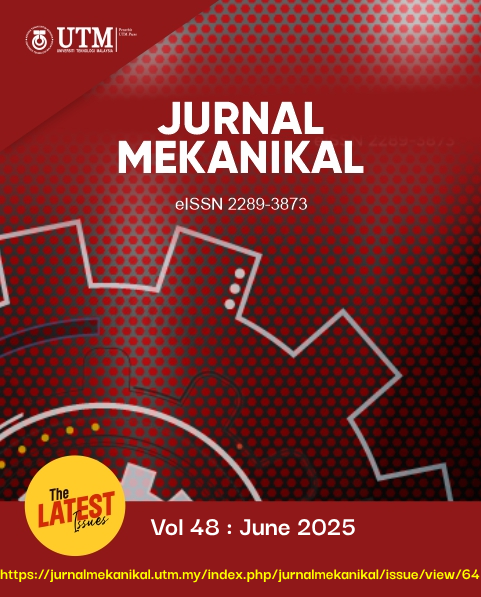3D Printing Study for Batik Canting Pattern Drawing
DOI:
https://doi.org/10.11113/jm.v48.560Keywords:
3D Printing, Canting, Batik, Cold Wax, Batik Pattern.Abstract
The new 3D printing technology has opened an opportunity for rapid prototyping, providing a relatively fast and cost-efficient product development. Previous research on the automation of Batik Lukis technology has shown that 3D printing technologies are applicable avenues for customising the automation of batik patterns and design. The printability of batik wax, which is dependent on the printhead mechanism to expel the wax, and the extrudability of paste-type filling, which is dependent on the rheology of the wax itself, are two major issues in paste printing. The first difficulty addressed in this project is the mechanism for ejecting the batik wax paste into a predetermined design. Although there are widely accessible CNC machines for this purpose, such as the Batik Klowong Machine, which are popular in the markets, particularly in Indonesia, this project attempts to use 3D printing to print batik wax by changing the printhead mechanism. Results shows that low extrusion steps of 8 extrusion steps per millimeter are potentially good extrusion speeds for viscous fluid like canting cold wax. Even though the wax line barrier produced by 8 extrusion steps has some increment in width of 1 to 2 mm, the line produced seems relatively more consistent than any other extrusion steps.
References
Baas, S., & Saggiomo, V. (2021). Ender3 3D printer kit transformed into open, programmable syringe pump set. HardwareX, 10, e00219.
Huang, C. Y. (2018). Extrusion-based 3D printing and characterization of edible materials. 12, 8–25.
Akhmad, S., et al. (2020). Design of the mBatik, textile hot wax applicator to emulate hand drawn batik using CNC plotter machine and characterization of wax plotting parameters. Journal of Physics: Conference Series, 1569.
Sudiarso, A., & Kusumawardani, R. (2018). Implementation of batik machine to improve hand-drawn batik production time. International Conference on Community Engagement and Education for Sustainable Development (ICCEESD), 24, 150–157.
Fitrahudin, R., & Sudiarso, A. (2017). Perancangan canting batik dan mekanisme penggantian otomatis canting batik tulis pada mesin CNC. Seminar Nasional – XVI Rekayasa dan Aplikasi Teknik Mesin di Industri Kampus ITENAS – Bandung, 1693, 1–6.
Muthi'Ah, W. (2018). Study of computerized-batik technique using 'batik kelowong' machine in batik Adelia, Bekasi. IOP Conference Series: Materials Science and Engineering, 453.
Kudiya, K., et al. (2014). The waxing optimization in finding the best melting point of wax for staining Cirebon batik. Art and Design Studies, 20, 10–19.
Kudiya, K., et al. (2016). Batik artisans' judgment of batik wax quality and its criteria: An application of the many-facets Rasch model. Pacific Rim Objective Measurement Symposium (PROMS) 2016 Conference Proceedings, 2, 27–37.
Sharifah, I. S. S., et al. (2017). Thermal modelling and analysis of batik canting design. Procedia Engineering, 184, 326–333.
Zhu, S., et al. (2019). Extrusion-based 3D printing of food pastes: Correlating rheological properties with printing behaviour. Innovative Food Science and Emerging Technologies, 58, 102214.
Amza, C., et al. (2017). Paste extruder hardware add-on for desktop 3D printers. Technologies (Basel), 5, 50–55.
Liu, Z., et al. (2017). 3D printing: Printing precision and application in food sector. Trends in Food Science and Technology, 69, 83–94.
Soeprapto, E. F., & Cahyadi, D. (2022). Redesign of canting cold batik using Nigel Cross approach. Proceedings of the International Conference on Applied Science and Technology on Social Science 2021 (iCAST-SS 2021), 647, 487–491.
Guo, C. F., et al. (2019). A comparative study between syringe-based and screw-based 3D food printers by computational simulation. Computers and Electronics in Agriculture, 162, 397–404.
Tashman, J. W., et al. (2021). A high performance open-source syringe extruder optimized for extrusion and retraction during FRESH 3D bioprinting. HardwareX, 9, e00170.
Veteška, P., et al. (2021). Novel composite filament usable in low-cost 3D printers for fabrication of complex ceramic shapes. Applied Materials Today, 22, 123–126.
Rando, P., & Ramaioli, M. (2021). Food 3D printing: Effect of heat transfer on print stability of chocolate. Journal of Food Engineering, 294, 110115.
Chiang, C. K., et al. (2018). Single step and mask-free 3D wax printing of microfluidic paper-based analytical devices for glucose and nitrite assays. 194, 837–845.
Zhang, J., et al. (2022). Temperature analyses in fused filament fabrication: From filament entering the hot-end to the printed parts. 3D Printing and Additive Manufacturing, 9, 132–142.
Downloads
Published
How to Cite
Issue
Section
License
Copyright of articles that appear in Jurnal Mekanikal belongs exclusively to Penerbit Universiti Teknologi Malaysia (Penerbit UTM Press). This copyright covers the rights to reproduce the article, including reprints, electronic reproductions or any other reproductions of similar nature.


















